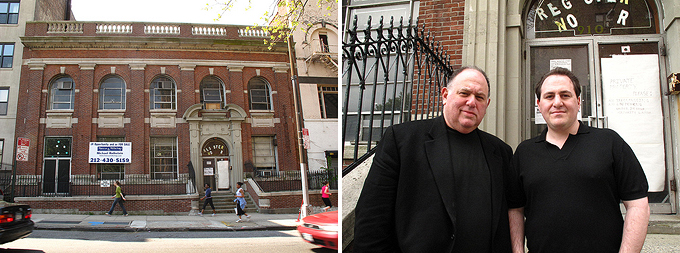Trending
Park Slope condo project gets a new developer
 From left: 910 Union Street, Perry Finkelman, and Brian Lockner
From left: 910 Union Street, Perry Finkelman, and Brian LocknerA new developer has taken over a beleaguered condominium project in Park Slope, with plans to add a four-story addition to the squat Depression-era building just outside the tony neighborhood’s landmark district.
Brian Lockner, head of acquisitions for American Development Group, the developer behind Little Italy’s 123 Baxter and its robotic parking garage, said his firm inked the deal early last month to take over construction of the 18-unit Park Slope project at 910 Union Street from Yachad Enterprises. Lockner said his company is having “very productive conversations with a few banks” and expects to secure financing by mid-summer.
The three-story brick building, most recently a church and schoolhouse, is one of roughly two dozen properties in Park Slope across from Prospect Park that are not protected by city landmark laws. Owners seeking to alter the exterior of a building within a landmark district must get approval from the city Landmarks Preservation Commission, which can add years to a project as transformative as the one Lockner’s firm is planning.
While 910 Union Street is among 1,350 buildings included in the first phase of a proposed expansion to the landmark district, the commission hasn’t yet scheduled the matter for consideration. And besides, the city Department of Buildings already approved the permit for the four-story addition two years ago, so the American Development Group can start building as soon as it gets financing.
“We want to be very respectful to the existing architecture, unlike our neighbor across the street,” said Perry Finkelman, principal of American Development Group, gesturing toward the glassy Richard Meier building, On Prospect Park, across Grand Army Plaza.
Finkelman said his building’s addition would be red brick and glass, featuring apartments with large kitchens and master bedrooms that families can congregate in.
He said he’s confident that units will sell given the tight supply in the mostly landmarked neighborhood — ranked this week by New York magazine as the city’s most liveable — and the fact that the project will be finished more than two years from now, when the recession is expected to be over.
One special unit in the back of the building would have soaring ceilings and a totally retro interior, complete with a restored wood-burning fireplace, glass doorknobs and 1950s-style, thunderbird green kitchen appliances, Finkelman said.
The Park Slope Civic Council, which is pushing for the historic district expansion, so far seems supportive of the project as long as the architectural details are contextual with the surrounding buildings.
“As much as we’re interested in expanding the historic district, we’re equally as interested in contextual development,” said Michael Cairl, chairman of the group’s liveable streets committee.
The People’s Cathedral of Brooklyn sold the property to developer Jacob Pinson for $5 million two years ago, but it has sat vacant since. It was not immediately clear why Pinson’s development interest was transferred to the American Development Group; Lockner only said Pinson wouldn’t have been able to complete the project or get financing, and Pinson did not return requests for comment.
Lockner said the family investment group that partnered with Pinson, Rima Holdings, is still involved in the project. Calls made to Rima Holdings were not returned by press time.




